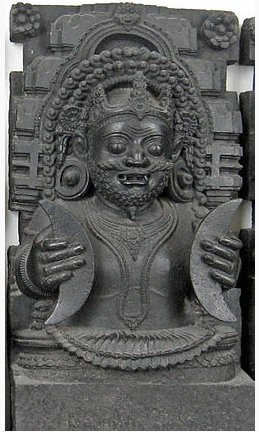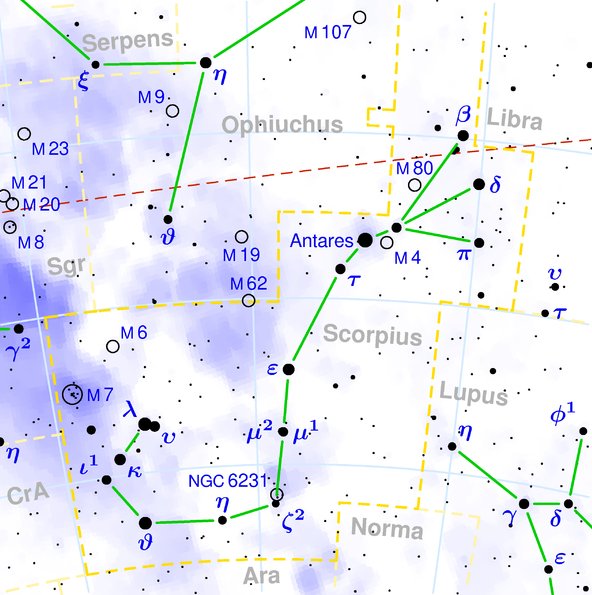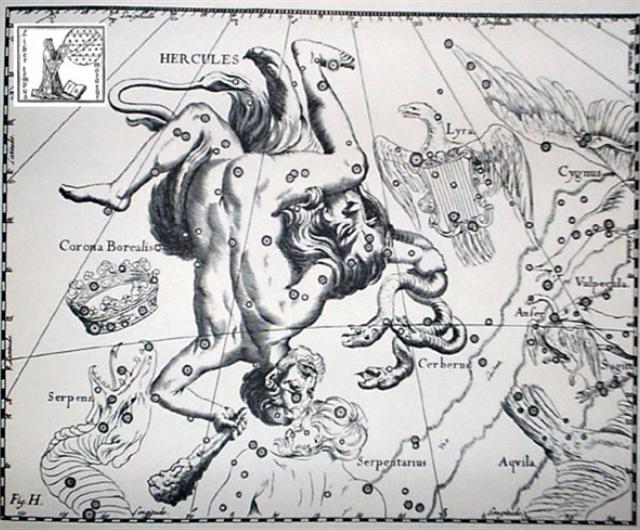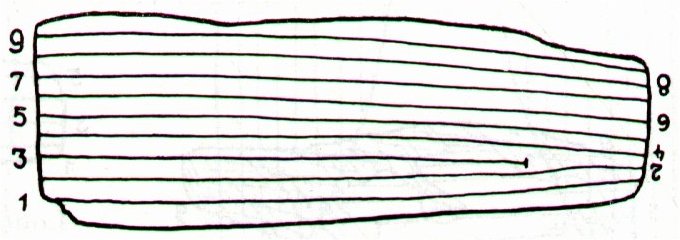6-9. I noticed that
the 'chief was lying on the ground with his
hands clenched and his toes twitching'. Hands clenched
suggests 'nothing as yet had been counted' (→ zero);
... The practice of turning
down the fingers, contrary to our practice, deserves
notice, as perhaps explaining why sometimes savages are
reported to be unable to count above four. The European
holds up one finger, which he counts, the native counts
those that are down and says 'four'. Two fingers held
up, the native counting those that are down, calls
'three'; and so on until the white man, holding up five
fingers, gives the native none turned down to count. The
native is nunplussed, and the enquirer reports that
savages can not count above four ...
and toes twitching is not far from
moving one's feet (kua kau → November 28). And this in
turn could suggest the sound of feet:
... Maeha
heard something, namely the noise that the men made, and he
said [he-ki mai mai te rua painga] from the other
side (of the house) to Teke, 'Hey you! This is the first
time that such a noise has been heard at night.'
[he ki mai a Teke] Teke answered from his side (of
the house) [mai toona painga], 'My feet have
made the noise that you heard.' [he vae ooku tau hetu
ena.a koe hakarongo ena] And he very carefully [koro
iti] made a noise [hakahetu] with his feet [i
toona vae] ... [E:59]
According to the Hawaiians the
cycle of Lono (Rogo) began in November 28, and the
concept of Rogo incorporated sounds.
Rogo.
Rogorogo: Originally,
'orators, bards' of Mangareva. Borrowed into the Rapanui
language in 1871, it came to generically signify the wooden
tablets incised with glyphs, the writing system itself, and
the respective inscriptions. Earlier the term ta was
used for the writings. Fischer. Mgv.: rogouru,
ten. Mq.: onohuu, okohuu, id. Churchill.
The bards on Easter Island were
using their rongorongo tablets in the last quarter of the
Moon, and this structural feature of the month could have
been transferred to the calendar for the Sun.
... The correspondence between the winter solstice and the
kali'i rite of the Makahiki is arrived at as
follows: ideally, the second ceremony of 'breaking the
coconut', when the priests assemble at the temple to spot
the rising of the Pleiades, coincides with the full moon (Hua
tapu) of the twelfth lunar month (Welehu). In
the latter eighteenth century, the Pleiades appear at sunset
on 18 November. Ten days later (28 November), the Lono
effigy sets off on its circuit, which lasts twenty-three
days, thus bringing the god back for the climactic battle
with the king on 21 December, the solstice (= Hawaiian 16
Makali'i). The correspondence is 'ideal' and only rarely
achieved, since it depends on the coincidence of the full
moon and the crepuscular rising of the Pleiades ...
|
May 27 |
28 (148, *68) |
29 |
30 |
 |
 |
 |
 |
|
Ea6-17 |
Ea6-18 |
Ea6-19 |
Ea6-20 (198) |
|
tagata mau - moa |
te honu paka |
moa |
kua kau |
|
Paka.
1. Dry; to become dry (of things);
pakapaka, to dry out. Te paka is also the
name of the moss-covered areas, between the small lakes
of volcano Rano Kau, through which one can pass
without getting one's feet wet. 2. To go, to depart;
he-paka-mai, to come; he-oho, he-paka, they
go away. 3. To become calm (of the sea): ku-paka-á te
tai. Pakahera, skull, shell, cranium;
pakahera puoko tagata, human skull; pakahera
pikea, shell of crab or crayfish. Gutu pakapaka,
scabbed lips. Hau paka, fibres of the hauhau
tree, which were first soaked in water, then dried to
produce a strong thread. Moa gao verapaka,
chicken with bald neck. Ariki Paka, certain
collateral descendents of Hotu Matu'a, who
exercised religious functions. Vanaga. 1. Crust, scab,
scurf; paka rerere, cancer; pakapaka,
crust, scabby. 2. Calm, still. 3. Intensive; vera
paka, scorching hot; marego paka, bald;
nunu paka, thin. 4. To arrive, to come. 5. To be
eager. 6. To absorb. 7. Shin T. Pakahera,
calabash, shell, jug. Pakahia, to clot, curdle,
coagulate. Pakapaka, dry, arid, scorching hot,
cooked too much, a desert, to fade away, to roast, a
cake, active; toto pakapaka, coagulated blood;
hakapakapaka, to dry, to broil, to toast.
Pakahera pikea, shell of crab or crayfish.
Churchill.
Kau. 1. To move one's feet
(walking or swimming); ana oho koe, ana kau i te
va'e, ka rava a me'e mo kai, if you go and move your
feet, you'll get something to eat; kakau (or also
kaukau), move yourself swimming. 2. To spread (of
plants): ku-kau-áte kumara, the sweet potatoes
have spread, have grown a lot. 3. To swarm, to mill
around (of people): ku-kau-á te gagata i mu'a i tou
hare, there's a crowd of people milling about in
front of your house. 4. To flood (of water after the
rain): ku-kau-á te vai haho, the water has
flooded out (of a container such as a taheta). 5.
To increase, to multiply: ku-kau-á te moa, the
chickens have multiplied. 6. Wide, large: Rano Kau, 'Wide
Crater' (name of the volcano in the southwest corner of
the island). 7. Expression of admiration: kau-ké-ké!
how big! hare kau-kéké! what a big house!
tagata hakari kau-kéké! what a stout man! Vanaga. To
bathe, to swim; hakakau, to make to swim. P Pau.,
Mgv., Mq.: kau, to swim. Ta.: áu, id.
Kauhaga, swimming. Churchill. The
stem kau does not appear independently in any
language of Polynesian proper. For tree and for timber
we have the composite lakau
in various stages of transformation. But kau will
also be found as an initial
component of various tree names. It is in Viti that we
first find it in free existence. In Melanesia this form
is rare. It occurs as kau in Efaté, Sesake, Epi,
Nguna, and perhaps may be preserved in Aneityum; as
gau in Marina; as au in Motu and somewhere in
the Solomon islands. The triplicity of the Efaté forms [kasu,
kas, kau] suggests a possible transition.
Kasu and kas are easy to be correlated,
kasu and kau less easy. They might be linked
by the assumption of a parent form kahu, from
which each might derive. This would appear in modern
Samoan as kau; but I have found it the rule that
even the mildest aspirate in Proto-Samoan becoming
extinct in modern Samoan is yet retained as aspiration
in Nuclear Polynesia and as th in Viti, none of
which mutations is found on this record. Churchill 2 |
|
REVERSED NAKSHATRA → CLOSE TO THE FULL MOON: |
|
Nov 25 (329, *249) |
26 |
27 |
28 |
|
Al Kalb-16 (The Heart)
/
Jyeshtha-18 (Eldest) /
ANA-MUA-1 (Entrance pillar)
ANTARES = α Scorpii
(249.1),
MARFIK (Elbow) = λ Ophiuchi,
φ Ophiuchi (249.5), ω Ophiuchi (249.8) |
γ Apodis (250.1), σ Herculis (250.3), θ Tr. Austr.
(250.6), τ Scorpii (250.7) |
HAN = ζ Ophiuchi
(251.0) |
ζ Herculis, η Tr. Austr. (252.1), η Herculis, β Apodis
(252.5) |
|
SEPT 22 (*185) |
23 |
24 |
25
(*188) |
|
... Antares, visible
in the morning sky of December-January, came to stand
for summer heat; hence the saying, 'Rehua cooks
(ripens) all fruit' [hakatupu].
The generally accepted version of the Rehua myth,
according to Best, is that Rehua had two wives,
the stars on either side of Antares. One was
Ruhi-te-rangi or Pekehawani, the
personification of summer languor (ruhi), the
other Whaka-onge-kai, She-who-makes-food-scarce
before the new crops can be harvested ...

... Antares is
visible in the sky all night around May 31 of each year,
when the star is at opposition to the Sun. At this time,
Antares rises at dusk and sets at dawn. For
approximately two to three weeks on either side of
November 30, Antares is not visible in the night sky,
because it is near conjunction with the Sun; this period
of invisibility is longer in the Northern Hemisphere
than in the Southern Hemisphere, since the star's
declination is significantly south of the celestial
equator ...
Rerehu,
Burning; a Maori name for Antares related to Rehua.
Rerehu presided over the sixth month
November-December in Stowell's enumeration, while
Tregear associated Rerehu with the ninth month,
February-March. Rehu is found in the Hawaiian
star and month name Welehu, the Tuamotuan
Herehu, and in the Rehu, Varehu, and
Avarahu of the Society Islands ... Herehu
is a Tuamotuan star whose name suggests the Maori
Rerehu and Rehua and the Marquesan Ehua,
all names for Antares. The Hawaiian equivalent lehu
is found in the star name Lehuakona,
Lehua-of-the-south. Rehu is seen in such month
names a Serehu of Tongareva, Welehu of
Hawaii, and Rehu and Varehu of the Society
Islands ... Waerehu is listed as a Maori star and
was a name for Antares among the Moriori as well as for
the month of January.
Hu. 1. Breaking of wind. T Mgv.,
uu, to break wind. Mq., Ta.: hu, id. 2.
Whistling of the wind, to blow, tempest, high wind. P
Pau.: huga, a hurricane. Churchill. Mgv.: hu,
to burst, to crackle, to snap. Ha.: hu, a noise.
Churchill.
Rehu.
1. Dust. P Mgv.: rehu, a cinder, coal,
ashes. Mq.: éhuahi, ashes. Ta.: rehu,
ashes, soot, any powder. 2. To omit, to forget, to
faint. Rehurehu, to omit, omission, lost to
sight. Hakarehu, to surprise. Rehua,
unintelligible. Churchill. Mgv.: rehurehu, from
early dawn to mid morning. Ta.: rehurehu,
twilight. Mq.: ehuehu, id. Churchill. Mq.: ehu,
to fall in bits. Ma.: rehu, to split off in
chips. Ehua, Ehuo, a large constellation.
Ma.: rehua, a star or planet, probably Jupiter.
Churchill. |
|
INVISIBLY CLOSE TO
THE SUN: |
|
No star listed (67) |
Rohini-4 (The Red One)
/
Pidnu-sha-Shame-4 (Furrow of Heaven)
/
ANA-MURI-2
(Rear pillar - at the foot of which was the place for
tattooing)
ALDEBARAN = α Tauri
(68.2),
THEEMIN = υ² Eridani
(68.5) |
No star listed (69) |
No star listed (70) |

... In Hindu
tradition, Rahu is a cut-off head of an asura, that
swallows the sun or the moon causing eclipses. He is depicted in
art as a serpent with no body riding a chariot drawn by eight
[8] black horses ... According to legend, during the Samudra
manthan, the asura Rahu drank some of the divine
nectar. Sun and moon realized it and they alerted Mohini
(the female avatar of Vishnu). Before the nectar could
pass his throat, Mohini cut off his head. The head,
however, remained immortal. It is believed that this immortal
head occasionally swallows the sun or the moon, causing
eclipses. Then, the sun or moon passes through the opening at
the neck, ending the eclipse
... |
From the Full Moon close to the
right ascension line connected with ζ Scorpii (i.e. the place
of December 1 = *255) to right ascension day *355 there were
100 days. 80 + 255 = 335 (December 1) → 364 - 29.
According to the era of Bharani
the position of ζ Scorpii would have been precisely *214.0,
corresponding to day 294 ("October 21).
... The Hawaiian
woman who was interviewed chuckled because the assassination of
Captain Cook coincided with the day we have named All Hearts'
Day - when in February 14 (2-14) the war-god Kuu
returned to power ...

|
May 31 |
June 1 (100 + 52) |
→
Terminalia |
3 (100 + 54) |
4
→ Febr 25 (420) |
 |
 |
 |
 |
 |
|
Ea6-21 |
Ea6-22 (200) |
Ea6-23 |
Ea6-24 |
Ea6-25 |
|
moa |
moe te goe |
moa |
moe te goe |
moa |
|
Goe. Milky Way. Vanaga.
... This
Snake-river of sparkling dust, the stream of the
abyss on high through which it runs, the golden cord
of the heaven-god ... connected alike with the hill
of the Sun-god and with the passage of ghosts, is
the Milky
Way ... |
|
REVERSED
NAKSHATRA → CLOSE TO THE FULL MOON: |
|
Nov 29 (333) |
30 |
Dec 1 (*255) |
2 (4 * 84) |
3 |
|
"Oct 19 |
20 |
21 (*214) |
22 (295) |
23 |
|
ATRIA = α Tr. Austr.
(253.9) |
Tail-6 (Tiger)
WEI (Tail) = ε Scorpii,
η Arae (254.3),
DENEBAKRAB = μ Scorpii
(254.7) |
ι Ophiuchi (255.3),
GRAFIAS = ζ Scorpii (255.4)
*214.0 = *255.4 - *41.4 |
κ Ophiuchi (256.2), ζ Arae (256.5), ε Arae (256.8),
CUJAM (Club) = ε Herculi
(256.9) |
No star listed (257) |

 |
|
SEPT 26 |
27 |
28 (*191) |
29 |
30 |
|
INVISIBLY CLOSE TO
THE SUN: |
|
TABIT =
π³
Orionis
(71.7),
π²
Orionis (71.9) |
π4
Orionis (72.1),
ο¹
Orionis (72.4),
π5
Orionis (72.8)
*31.0 = *72.4 - *41.4 |
π¹
Orionis (73.0),
ο²
Orionis (73.4),
HASSALEH =
ι
Aurigae
(73.6),
π6
Orionis (73.9)
*32.0 = *73.4 - *41.4 |
ALMAAZ (The Male Goat)
=
ε
Aurigae
(74.7),
HAEDUS I =
ζ
Aurigae
(74.8) |
HAEDUS II = η Aurigae
(75.9) |
 |
Clearly, we can see, the creator of
the E text has documented the emergence of something new after the
sleep in the Milky Way:
|
June 5 (156 → 2 * 78) |
6 |
7 (*78) |
8 |
 |
 |
 |
 |
|
Ea6-26 |
Ea6-27 |
Ea6-28 |
Ea6-29 (207) |
|
manu rere |
moa |
kua oro |
moa |
|
Oro.
1. To flit
in the air (of a bird), turning and flying up and
down. 2. To file, to scratch, to scrub, to grind, to
sharpen; ka-oro te kumara, grind the sweet
potatoes; ka-oro te hoe, sharpen the knife.
Orooro, to rub, to polish, to shine. Vanaga.
Oroina,
to choke on a fish bone.
Orooro,
to whet, to sharpen (horo).
Churchill. |
|
REVERSED
NAKSHATRA → CLOSE TO THE FULL MOON: |
|
Dec 4 |
5 |
6 (*260) |
7 (341 → 300 +
41) |
|
"Oct 24 |
25 |
26 |
27 (*220) |
|
17h
(*258.7)
ARRAKIS = μ Draconis
(258.7) |
Mula-19 (The Root)
SABIK (The Preceding One) =
η
Ophiuchi
(259.7),
η
Scorpii (259.9) |
NODUS I =
ζ
Draconis
(260.0),
π
Herculis (260.7),
RAS ALGETHI =
α
Herculis
(260.8) |
SARIN =
δ
Herculis
(261.0),
ο
Ophiuchi (261.4)
*220.0 = *261.4 - *41.4
ALRISHA (α Piscium) |
 |
 |
|
OCT 1 |
2 |
3 (*196) |
4 |
|
INVISIBLY CLOSE TO
THE SUN: |
|
5h (*76.1)
ε
Leporis (76.0),
CURSA (Footstool) =
β
Eridani (76.4),
λ
Eridani (76.7)
*35.0 = *76.4 - *41.4 |
μ Aurigae, μ Leporis (77.6) |
ĸ Leporis (78.0),
RIGEL (Foot) =
β
Orionis
(78.1),
Flaming Star = IC405
(78.2),
CAPELLA (Mother Goat) =
α
Aurigae (78.4),
ο
Columbae,
τ
Orionis (78.8)
*37.0 = *78.4 - *41.4
THUBAN (α Draconis) |
λ Aurigae (79.0), λ Leporis (79.6), ρ Aurigae (79.7) |
 |
June 5 → 65 was day 156 →
Tania Australis,
suggesting the addition of 100 and a reversal from 13 * 5
(→ May 15) to 7 * 8.
135 → 500 (the day before Alcyone)
and 7 * 8 → 78 (Rigel and the culmination of
Thuban).
|
ALCYONE (*56 → 2
* 28) |
a1 |
32 |
32 |
|
BETELGEUZE (*88) |
a2 |
33 |
65 |
|
NAOS (*121
→
11 * 11) |
a3 |
35 |
100 |
 |
|
TANIA AUSTRALIS
(*156 → 2 * 78) |
a4 |
36 |
78 |
|
PORRIMA (*191) |
a5 |
42 |
|
NUSAKAN (*156 +
*78) |
a6 |
39 |
156 |
|
NASH (*273 → 3 * 91) |
a7 |
39 |
From the end of the prematurely
cutoff glyph line Ea3 to the emergence of the little bird in day
156 (Ea6-26) there were 204 - 100 = 104 days:
|
 |
103 |
 |
|
ANCHA (*337.4) |
CURSA (*76.4) |
|
Ea3-35 (100) |
Ea6-26
|
In the tresses of Pachamama,
we remember, there were both 214 and 104:
|
Counting the tresses from right
to left: |
|
1 |
26 |
78 |
1 |
29 |
90 |
|
2 |
26 |
2 |
30 |
|
3 |
26 |
3 |
31 |
|
4 |
25 |
104 |
4 |
34 |
124 |
|
5 |
26 |
5 |
31 |
|
6 |
27 |
6 |
30 |
|
7 |
26 |
7 |
29 |
|
Total = 396 = 182 +
214 |
214 + 104 + 78 = 396.
The
pattern 6 + 4 = 10 then seems
to continue:
 |
 |
 |
 |
 |
 |
|
Ea6-30 (2 * 104) |
Ea6-31 |
Ea6-32 |
Ea6-33 |
Ea6-34 |
Ea6-35 |
|
manu kake rua |
marama 2 |
tagata uru - vai |
hokohuki - kiore |
hokohuki - kiore |
|
Kake. Kakea, to come near, to embark. P Pau.:
kake, to climb, to ascend. Mgv.: kake,
the arrival of shoals of spawning fish. Mq.: kake,
to climb up a valley. Ta.: ae, to climb, to
ascend. Churchill. Mgv.: kake, to strike on
an ocean reef. Ta.: ae, to strand. Churchill.
Sa.: a'e, upward, to go up; sa'e, to
elevate one leg, as in the act of falling in a club
match; 'a'e, to ascend, to rise. To.: hake,
upward, to ascend. Fu.: ake, up, to ascend;
sake, ro raise the leg at one in derision or
mockery; kake, to climb, to ascend. Niuē:
hake, up, going up. Uvea: ake, up;
kake, to go up. Ma.: ake, upward; kake,
to climb, to ascend. Mq.: ake, on high,
upward; kake, to ascend. Mgv.: ake,
upward. Bukabuka: ake, up. Ta.: ae,
up, to go up, to ascend, to climb. Ha.: ae,
to raise, to lift up, to mount. Fotuna:
no-jikijiake, to lift up; no-tukake, to
stand upright. Nukuoro: kake, to go up.
Nuguria: kake, up; hanage, northwest.
Rapanui: kake a, to go abroad. Vi.: thake,
upward; thaketa, to dig or lift up. Churchill
2. |
 |
 |
 |
 |
|
Ea6-36 (2 * 107) |
Ea6-37 |
Ea6-38 |
Ea6-39 |
|
tagata hakareva |
ka reva te ika |
e atu te ika |
ko te ika |
|
Reva.
To hang
down; flag, banner. Revareva, 1. To be
hanging vertically; to detach oneself from the
background of the landscape, such a person standing
on top of a hill: ku-revareva-á te tagata i ruga
i te maúga. 2. To cast itself, to project itself
(of shadows); revareva-á te kohu o te miro i te
maeha o te mahina, the shadow of the tree casts
itself in the light of the moon. 3. Uvula. Vanaga.
To hang, to suspend, flag, banner; hakareva,
to hang up; hakarereva, to hang up, to
balance; hakarevareva, to wave. T Pau.:
reva, a flag; fakarevareva, to hang up,
to suspend. Mgv.: reva, a flag, a signal.
Mq.: éva, to hang up, to be suspended, to
wave a signal. Ta.: reva, a flag, banner;
revareva, to wave. The germ sense is that of
being suspended ... any light object hung up in the
island air under the steady tradewind will flutter;
therefore the specification involved in the wave
sense is no more than normal observation. Churchill.
Mgv.: 1. A plant. Ta.: reva, id. Mq.: eva,
id. Sa.: leva, id. Ma.: rewa-rewa, id.
2. To cross, to pass across quickly; revaga,
departure. Ta.: reva, to go away, to depart.
Ma.: reva, to get under way. Churchill. Ta.:
The firmanent, atmosphere. Ha.: lewa, the
upper regions of the air, atmosphere, the visible
heavens. Churchill.
Atu.
Particle of meaning opposite to that of mai;
it refers to the second or third person, expressing
movement away: ka-avai-atu, give it to him:
he-oho-atu au, I am going there, after you;
i-oho-atu-era, when I had gone there. Vanaga.
1. a. Directive, of motion from the speaker. b.
Somewhat expressive of the comparative degree. 2.
Pupil; hakaatu, proof; hare hakaatuga,
schoolhouse, class. 3. (hakaatu), to presage.
4. (hakaatu), mark, object. Churchill. |
 |
64 |
 |
|
Ea5-16 (152)
|
Ea6-39
(217) |
|
ALSEIPH (*24.5) |
ξ Columbae (*88.5) |

|





















